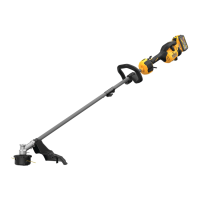b ) Do not use the power tool if the switch does not turn it on and off. Any power tool that cannot be controlled with the switch is dangerous and must
be repaired.
c ) Disconnect the plug from the power source and/ or remove the battery pack, if detachable, from the power tool before making any adjustments,
changing accessories, or storing power tools. Such preventive safety measures reduce the risk of starting the power tool accidentally.
d ) Store idle power tools out of the reach of children and do not allow persons unfamiliar with the power tool or these instructions to operate the power
tool. Power tools are dangerous in the hands of untrained users.
e ) Maintain power tools and accessories. Check for misalignment or binding of moving parts, breakage of parts, and any other condition that may
affect the power tool’s operation. If damaged, have the power tool repaired before use. Many accidents are caused by poorly maintained power tools.
f ) Keep cutting tools sharp and clean. Properly maintained cutting tools with sharp cutting edges are less likely to bind and are easier to control.
g ) Use the power tool, accessories and tool bits, etc. in accordance with these instructions, taking into account the working conditions and the work to
be performed. Use of the power tool for operations different from those intended could result in a hazardous situation.
h ) Keep handles and grasping surfaces dry, clean, and free from oil and grease. Slippery handles and grasping surfaces do not allow for safe
handling and control of the tool in unexpected situations.
Battery Tool Use and Care
a ) Recharge only with the charger specified by the manufacturer. A charger that is suitable for one type. of battery pack may create a risk of fire when
used with another battery pack.
b ) Use power tools only with specifically designated battery packs. Use of any other battery packs may create a risk of injury and fire.
c ) When battery pack is not in use, keep it away from other metal objects, like paper clips, coins, keys, nails, screws or other small metal objects, that
can make a connection from one terminal to another. Shorting the battery terminals together may cause burns or a fire.
d ) Under abusive conditions, liquid may be ejected from the battery; avoid contact. If contact accidentally occurs, flush with water. If liquid contacts
eyes, additionally seek medical help. Liquid ejected from the battery may cause irritation or burns.
e ) Do not use a battery pack or tool that is damaged or modified. Damaged or modified batteries may exhibit unpredictable behavior resulting in fire,
explosion or risk of injury.
f ) Do not expose a battery pack or tool to fire or excessive temperature. Exposure to fire or temperature above 265 °F (130 °C) may cause explosion.
g ) Follow all charging instructions and do not charge the battery pack or tool outside the temperature range specified in the instructions. Charging
improperly or at temperatures outside the specified range may damage the battery and increase the risk of fire.
Service
a ) Have your power tool serviced by a qualified repair person using only identical replacement parts. This will ensure that the safety of the power tool
is maintained.
b ) Never service damaged battery packs. Service of battery packs should only be performed by the manufacturer or authorized service providers.
Additional Safety Information
WARNING: Never modify the power tool or any part of it. Damage or personal injury could result.
WARNING: ALWAYS use safety glasses. Everyday eyeglasses are NOT safety glasses. Also use face or dust mask if operation is dusty.
ALWAYS WEAR CERTIFIED SAFETY EQUIPMENT:
ANSI Z87.1 eye protection (CAN/CSA Z94.3),
ANSI S12.6 (S3.19) hearing protection,
NIOSH/OSHA/MSHA respiratory protection.
WARNING: Some dust contains chemicals known to State of California to cause cancer, birth defects or other reproductive harm. Some
examples of these chemicals are:
compounds in fertilizers,
compounds in insecticides, herbicides and pesticides,
arsenic and chromium from chemically treated lumber. To reduce your exposure to these chemicals, wear approved safety equipment such as
dust masks that are specially designed to filter out microscopic particles.
WARNING: Use of this tool can generate and/or disperse dust, which may cause serious and permanent respiratory or another injury. Always
use NIOSH/OSHA-approved respiratory protection appropriate for dust exposure. Direct particles away from face and body.
WARNING: Always wear proper personal hearing protection that conforms to ANSI S12.6 (S3.19) during use. Under some conditions and
duration of use, noise from this product may contribute to hearing loss.
CAUTION: When not in use, place tool on its side on a stable surface where it will not cause a tripping or falling hazard. Some tools with a large
battery pack will stand upright but may be easily knocked over.
Air vents often cover moving parts and should be avoided. Loose clothes, jewelry, or long hair can be caught in moving parts. The label on your
tool may include the following symbols. The symbols and their definitions are as follows:
BPM ……………….. beats per minute
V ……………………. volts
min ………………… minutes
or DC ………… direct current
…/min ………….. per minute
RPM ……………….. revolutions per minute
A ……………………. amperes
Hz ………………….. hertz

